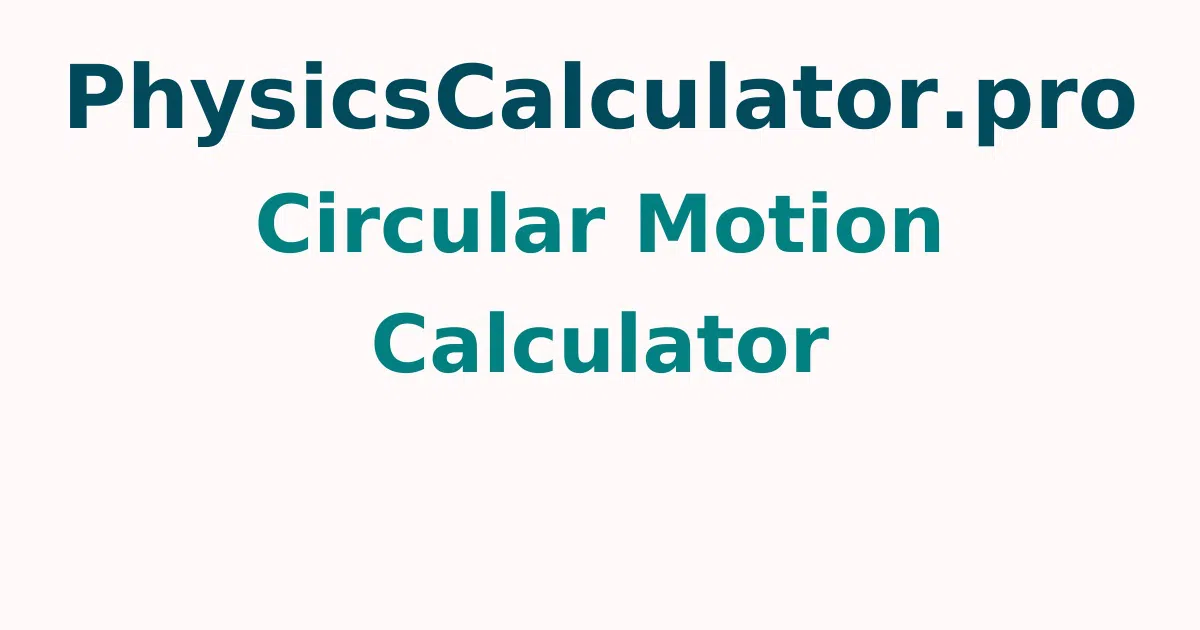Circular Motion Calculator
All of the properties of uniform circular motion can be calculated using an online circular motion calculator. Don't worry if you don't understand what uniform circular motion is or if circular motion formulas overwhelm you. Our circular motion calculator can assist you in understanding the physics concepts of uniform circular motion. Continue reading to learn about circular motion's definition, examples, and formulas. You'll also find examples of how to use our uniform circular motion calculator to calculate circular motion parameters like period, frequency, velocity, and acceleration.
Circular Motion Calculator
Result :
Solution :
How to calculate Circular Motion?
Let us consider an object moving along the circumference of a circle with radius r and center at O. Let the object move (in anti clock-wise direction) from P to Q in time t. The physical quantities that describe this motion and the formulas for circular motion are:
ν = 1 / T
ω = 2 x π / T
where,
- ν - Frequency
- ω - Angular velocity
- T - Time
Frequency (ν) = 1 /
Frequency (ν) = Hz
Angular velocity (ω) = 2 x 3.1416 /
Angular velocity (ω) = rad/sec
Circular Motion
A circular motion is defined as an object moving in a circular route. Circular motion can be demonstrated in a variety of ways, including:
- On a circular curve, a race car is moving.
- A man-made satellite orbiting the globe; the tip of a clock's minute/second hand; and a stone whirling on a string
- A uniform circular motion or a non-uniform circular motion can occur when an object rotates in a circle.
The direction of motion is constantly changing in a circular motion. A body moving in a circular path has its direction of motion along the tangent to the circle at any given time. Imagine a stone whirling on a string; when the string snaps, the stoneflies in a tangential direction.
What does it mean by Uniform Circular Motion?
The object moves along a circular path at a constant speed in a uniform circular motion. This signifies that the object will travel the circumference of the circle in the same amount of time at equal intervals. The speed of the object changes in a non-uniform circular motion.
In a uniform circular motion, the speed is constant, but the direction of motion is constantly changing, as we saw in the previous section. Hence, the velocity of an object moving in a circular pattern changes with time. The object experiences centripetal acceleration, which is caused by a change in the direction of the motion.
We know from Newton's first law of motion that a body cannot change its motion direction on its own. This necessitates the use of an external force. Centripetal force is the external force that maintains an object moving in a circular path.
Find similar concepts related to physics all under one roof at Physicscalculatorpro.com and resolve all your doubts as a part of your homework or assignment.
In a Circular Motion, How can I Calculate Acceleration?
Follow these steps to determine the centripetal acceleration in a circular motion:
- Step 1: Calculate the linear velocity's square.
- Step 2: Subtract the radius of the circular path from the value in step 1.
- Step 3: In a circular motion, you easily determined the centripetal acceleration.
FAQs on Circular Motion Calculator
1. What is the formula for calculating circular motion?
A circumference is equal to the distance around a circle and is computed as 2•pi•R, where R is the radius. The period is the amount of time it takes to complete one revolution around the circle, and it is represented by the symbol T. As a result, the calculation 2•pi•R / T gives the average speed of an object moving along a circular path.
2. In a circular motion, what is the frequency?
The rate of rotation, or the number of rotations per unit of time, is defined as the frequency. The rotation rate in radians is known as angular frequency.
3. What is the circular motion velocity?
To summarise, an object travelling in uniform circular motion moves at a consistent speed around the circle's circumference. While the object's speed remains constant, its velocity changes. Velocity has a constant magnitude but a variable direction because it is a vector.
4. What is a circular motion revolution?
The earth revolves around the sun and revolution is a sort of circular motion in which an object moves around a fixed centre point called the axis of revolution that is some distance away from the object.
5. What is the centripetal force on a circularly moving object?
Any item travelling in a circle is subjected to centripetal force. The product of an object's mass and centripetal acceleration determines the magnitude of centripetal force. The centripetal force is directed towards the circle's centre.
